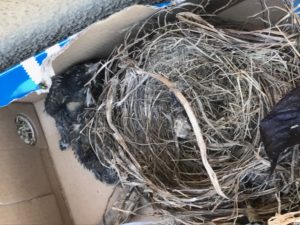How to doom a Robin’s nestlings without trying

An example of a nesting American Robin Photo by Tom Grey
The answer to this question has recently been learned (or possibly re-learned) by Artistic Maintenance of El Toro, California. Its client, the Homeowner’s Association of Saint Michel of Newport Coast, and their property management company, First Service Residential, can likely now provide the answer as well. In mid-July, two active bird nests were lost to the elective removal of plum trees in the residential community. A dead nestling of an unknown species was found by a resident on his property in the location of the first tree after it was removed. The removal of the second tree on the same property was witnessed by several residents. According to one homeowner who contacted First Service Residential, all plum trees were slated for removal (including the healthy ones) because most were not doing well. In retrospect, had
 the tree care providers thoroughly checked the trees for active nests before proceeding, the removal could have been delayed by two or three weeks until the birds had left the nest. Otherwise, a permit from the California Department of Fish and Wildlife is required to remove a tree in which birds are currently nesting.
the tree care providers thoroughly checked the trees for active nests before proceeding, the removal could have been delayed by two or three weeks until the birds had left the nest. Otherwise, a permit from the California Department of Fish and Wildlife is required to remove a tree in which birds are currently nesting.
The most generous term for this incident is ‘accidental.’ There was no indication that it was deliberate. Do a quick review of Federal and State bird protection regulations and you can call it something else. A violation. (Tree care providers are supposed to know wildlife protection laws.) If you listen to reports of eyewitnesses who attempted to assist the ejected baby robins while the crew continued dismembering the tree, the term ‘neglectful’ flashes like a neon sign. In this case, apparently thanks to pressure from witnesses, eventually the birds and their nest were put in a box. Witnesses report that about 45 minutes later, under further pressure, a worker relocated the birds and their nest in a nearby tree.
 Here again, lack of proper training was evident. The photo attached shows the nest was placed too-low and too-exposed, especially for the very high temperatures in Newport Coast at this time of year. Several hours later residents discovered the nestlings were missing, likely predated by a crow or other wildlife. Had the crew been trained to immediately call the closest wildlife rehabilitation center (in this case the Songbird Care and Education Center), they would have received helpful guidance, including how to prevent dehydration and exposure to predators, or possibly told to deliver the birds to the center.
Here again, lack of proper training was evident. The photo attached shows the nest was placed too-low and too-exposed, especially for the very high temperatures in Newport Coast at this time of year. Several hours later residents discovered the nestlings were missing, likely predated by a crow or other wildlife. Had the crew been trained to immediately call the closest wildlife rehabilitation center (in this case the Songbird Care and Education Center), they would have received helpful guidance, including how to prevent dehydration and exposure to predators, or possibly told to deliver the birds to the center.
In hindsight, regret and embarrassment do not revive dead birds. There is no mitigation for the ecological services these birds would have provided, nor for the loss of future generations of birds that the dead ones would have eventually produced. And there is no appeasement for the residents who until dusk that day, witnessed and photographed a frantic parent Robin roaming the area and calling for its young, only to resume this distressed behavior at dawn. (Look closely below at the photo to the right. The speck at the top of the center tree is the parent robin.)
On its website, Artistic Maintenance prides itself in training its workers to work “In Harmony with Nature.” Their focus is on plants and landscape management, of course. What the company appears to miss is that training should include law-abiding tree care to avoid harm to wildlife. The fact is that wildlife and plants are an integral part of nature, and both rely on and benefit each other. This emphasis is lacking among many tree care companies.
That said, property managers and HOAs are half the equation in exercising good stewardship. They can hire companies that are wildlife aware and trained, and consider potential impacts of tree care and landscape maintenance on wildlife during February through August when most species nest. Protecting native birds is not an option. It is the law. And tree care workers that ignore this run the risk of heavy fines, and in the most egregious circumstances, imprisonment. And they must endure bad press and public outcry. Here is an example in Newport Beach, CA.
Please require your tree care provider to use the guidelines included below, and urge them to take advantage of the training opportunity also listed. And please consider a donation to the Songbird Care and Education Center whose volunteers spend every nesting season caring for countless orphaned and injured birds without compensation from the unidentified people who caused such injuries.


Connect
Connect with us on the following social media platforms.